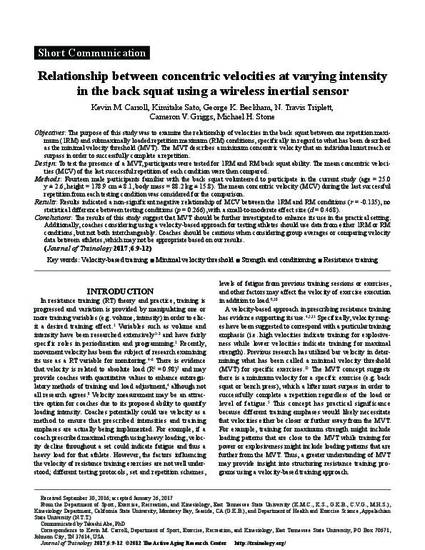
Objectives: The purpose of this study was to examine the relationship of velocities in the back squat between one repetition maximum (1RM) and submaximally loaded repetition maximum (RM) conditions, specifically in regard to what has been described as the minimal velocity threshold (MVT). The MVT describes a minimum concentric velocity that an individual must reach or surpass in order to successfully complete a repetition. Design: To test the presence of a MVT, participants were tested for 1RM and RM back squat ability. The mean concentric veloci ties (MCV) of the last successful repetition of each condition were then compared. Methods: Fourteen male participants familiar with the back squat volunteered to participate in the current study (age = 25.0 y ± 2.6, height = 178.9 cm ± 8.1, body mass = 88.2 kg ± 15.8). The mean concentric velocity (MCV) during the last successful repetition from each testing condition was considered for the comparison. Results: Results indicated a non-significant negative relationship of MCV between the 1RM and RM conditions (r = -0.135), no statistical difference between testing conditions (p = 0.266), with a small-to-moderate effect size (d = 0.468). Conclusions: The results of this study suggest that MVT should be further investigated to enhance its use in the practical setting. Additionally, coaches considering using a velocity-based approach for testing athletes should use data from either 1RM or RM conditions, but not both interchangeably. Coaches should be cautious when considering group averages or comparing velocity data between athletes, which may not be appropriate based on our results.
Available at: http://works.bepress.com/michael-stone/431/

©2012 The Active Aging Research Center. This document was published with permission by the journal. It was originally published in the Journal of Trainology.